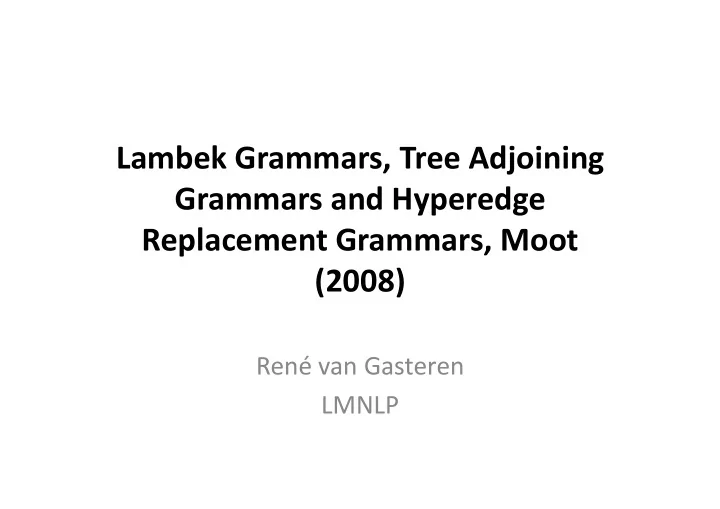

Lambek Grammars, Tree Adjoining Grammars and Hyperedge Replacement Grammars, Moot (2008) René van Gasteren LMNLP
Goal Show that both NL ◊ R and LG generate the same class of languages as TAGs, using hyperedge replacement grammars as an intermediate step.
Hyperedge Replacement Grammars Hypergraphs A hypergraph generalises the no/on of graph by allowing the edges, called hyperedges, to connect not just two but any number of nodes.
Hyperedge Replacement Grammars DefiniFon hypergraphs
Hyperedge Replacement Grammars Hyperedge Replacement The operaFon of hyperedge replacement replaces a hyperedge by a hypergraph H of the same type
Hyperedge Replacement Grammars DefiniFon Hyperedge Replacement
Hyperedge Replacement Grammars
Hyperedge Replacement Grammars
Tree Adjoining Grammars as HR Grammars Tree Adjoining Grammars can be see as a special case of hyperedge replacement grammars where: ‐ every non‐terminal hyperedge label has at most two tentacles, that is, the rank of the grammar is (at most) two. ‐ every right‐hand side of a HR rule is either: a tree with the root as its sole external node. a tree with a root and a leaf as its external nodes.
Tree Adjoining Grammars as HR Grammars Moot in a presentaFon: “Tree Adjoining Grammars can be seen as a special case of hyperedge replacement grammars.“ Moot in his paper : “HR 2 grammars genera/ng trees and TAG grammars are strongly equivalent.” QuesFon: Is this the same?
LTAG in normal form An LTAG nf grammar G is an LTAG saFsfying the following addiFonal condiFons: ‐ all internal nodes of elementary trees have exactly two daughters, ‐ every adjuncFon node either specifies the null adjuncFon or the obligatory adjuncFon con‐ straint without any selecFonal restricFons, ‐ every adjuncFon node is on the path from the lexical anchor to the root of the tree. For every LTAG grammar G there is a weakly equivalent LTAG’ grammar G �
LTAG nf as proof nets for NL ◊ R If G is an LTAG nf grammar, then there exists a strongly equivalent NL ◊ R grammar G’ and a strongly equivalent LG grammar G’’ tree. Proof sketch For each lexical tree t of G we construct a lexical tree t’ in G’ and a lexical tree t’’ in G’’ , translaFng every adjuncFon point by the leT hand side of the figure for G’ and by its right hand side for G’’ Whenever we subsFtute a tree…. Whenever we adjoin a tree….
Proof nets as HRG Links for proof structure
Proof nets as HRG Example
Proof nets as HRG ContracFons Same for other structural rules
Proof nets as HRG
Proof nets as HRG If G is a Lambek Grammar, then there exists a strongly equivalent HR grammar G’ .
Conclusion? NL ◊ R and LG are mildly context‐sensiFve formalisms and therefore benefit from the pleasant properFes this entails, such as polynomial parsability.
Conclusion? Melissen(2011) shows that LG recognises more than LTAG
Thanks
Recommend
More recommend